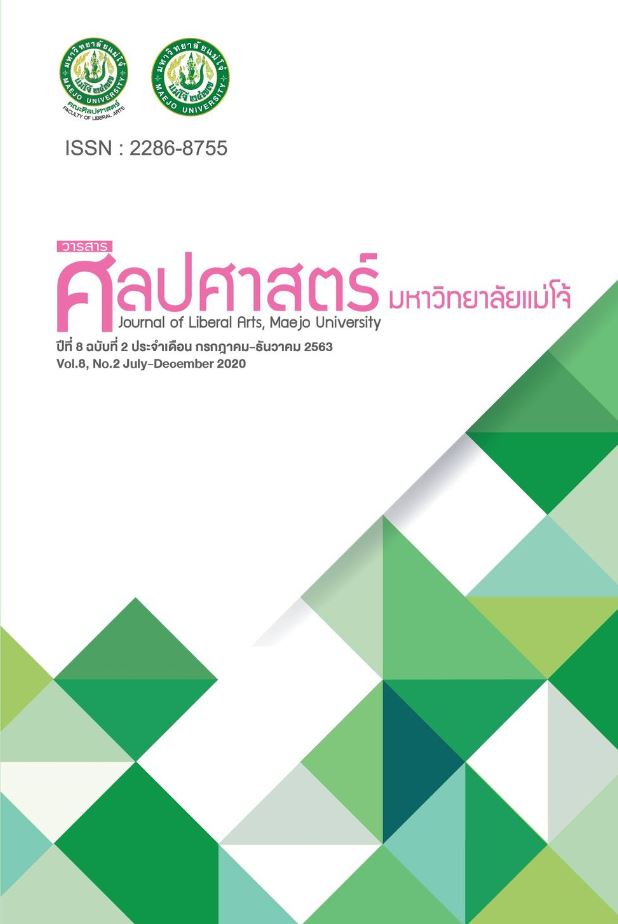Digital Divide through Individual Factors Analysis
Main Article Content
Abstract
Under the social context and the era which have changed rapidly, the development of digital technology to facilitate and improve life of people has caused custom changing such as the financial transactions, the communication and the business system. However, the opportunity to access to the digital technology is not for everyone due to various factors such as Critical information infrastructure, Government policy, Individual factors, etc. The objective of this journal paper was to present the document analysis and the research which has related to individual factors that affect to have the digital divide. The study found that those individual factors can cause the digital divide. Those individual factors are 1) population, 2) education and language skills, 3) economic and social status and 4) attitude. The analysis of these factors, will lead to better understanding and corrections to reduce the digital divide that arises.
Article Details
References
โกมาตร จึงเสถียรทรัพย์. (2562). มนุษย์ในโลกดิจิทัล. การประชุมวิชาการมานุษยวิทยาครั้งที่ 13, 4 กรกฎาคม 2562. ณ ศูนย์มานุษยวิทยาสิรินธร. นนทบุรี: สำนักวิจัยสังคมและสุขภาพ.
ข่าวรอบวัน. (2562). คนไทย ลดเหลื่อมล้ำ ด้านชีวิตดิจิทัลในรอบ 5 ปี. สืบค้น 24 มกราคม 2563. จาก https://www. moneyandbanking.co.th/new/26220/2/index.php.
ดิจิทัลเพื่อเศรษฐกิจและสังคม, กระทรวงดิจิทัลเพื่อเศรษฐกิจและสังคมแห่งชาติ. (2562). นโยบายและแผนระดับชาติว่าด้วยการพัฒนาดิจิทัลเพื่อเศรษฐกิจและสังคม (พ.ศ.2561-2580). สืบค้น 6 มกราคม 2563, จาก https://www.etda.or.th/content_files/2/files/05_Thailand_Digital_Plan.pdf.
ธีระพร อุวรรณโณ. (2528). การวัดทัศนคติ: ปัญหาในการใช้เพื่อทำนายพฤติกรรม. วารสารครุศาสตร์. 14(4), 133-160.
นิธิดา แสงสิงแก้ว. (2561). สื่อ สาร และผู้คน ในสังคมที่เปลี่ยนแปลง. ปทุมธานี: โรงพิมพ์มหาวิทยาลัยธรรมศาสตร์.
ปฐม อินทโรดม. (2562). Please Mind The Digital Gap… ประชากรดิจิทัลไทยในชายขอบ. สืบค้น 5 มิถุนายน 2563, จาก https://brandinside.asia/opinion-please-mind-the-digital-gap/.
โพสต์ทูเดย์. (2562). ม.รังสิต เปิดตัว “ดัชนีความเหลื่อมล้ำดิจิทัล” ชี้ 5 จว.กลุ่มวัยชรา เด็ก คนจนเข้าถึงดิจิทัลต่ำ. สืบค้น 2 ธันวาคม 2562, จาก https://www.posttoday.com/politic/news/594261.
วรพจน์ วงศ์กิจรุ่งเรือง. (2561). คู่มือพลเมืองดิจิทัล. กรุงเทพฯ: สำนักงานส่งเสริมเศรษฐกิจดิจิทัล กระทรวงดิจิทัลเพื่อเศรษฐกิจและสังคม.
สรานนท์ อินทนนท์. (2561). ความฉลาดทางดิจิทัล (DQ: Digital Intelligence). สืบค้น 8 สิงหาคม 2562. จาก http://cclickthailand.com/ความรู้เท่าทันสื่อ/เท่าทันสื่อ/fact-sheet-ความฉลาดทางดิจิทัล-dq-digital-intelligence.
สฤณี อาชวานันทกุล. (2560). ความเหลื่อมล้ำฉบับพกพา. สืบค้น 5 เมษายน 2563, จาก https://thaiinequality. org/pages/2-5.
สุขภาพจิต. (2559). แนวความคิดตามทฤษฎีจิตวิทยารายบุคคล อัลเฟรด แอดเลอร์. สืบค้น 5 เมษายน 2563,
จาก https://sites.google.com/site/sutttttttttttttt8/naew-khwam-khid-tam-thvsdi-citwithya-raybuk hkhl-xalfe-rd-xaed-lex-r.
สุทธาสินี มะสะกุล. (2551). ช่องว่างทางดิจิทัลของนักหนังสือพิมพ์ไทย เปรียบเทียบระหว่างประเภทหนังสือพิมพ์ที่สังกัดและสายงานที่รับผิดชอบ (วิทยานิพนธ์ปริญญามหาบัณฑิต). กรุงเทพฯ: จุฬาลงกรณ์มหาวิทยาลัย.
สุภารักษ์ จูตระกูล. (2557). 4 SCREEN กับการแสวงหาข่าวสารในยุคหลอมรวมสื่อ. วารสารวิทยาการจัดการ มหาวิทยาลัยราชภัฎเชียงราย. 9(2), 28-43.
เสาวรัจ รัตนคำฟู. (2563). วิกฤตโควิด-19 รัฐต้องเร่งลดช่องว่างดิจิทัล เพื่อความเท่าเทียมในห้องเรียนออนไลน์. สืบค้น 1 พฤษภาคม 2563, จาก https://tdri.or.th/2020/04/digital-divide-online-educationine qualities/.
Aleph Molinari. (2011). Let’s bridge the digital divide. ค้นเมื่อ 15 มีนาคม 2563 จาก https://www. ted.com/talks/aleph_molinari_let_s_bridge_the_digital_divide/transcript?language=th#t-582552.
Chair, C.. (2019). Walking the Talk: Feminist research to understand the African gendered digital divide. สืบค้น 5 มกราคม 2563, จาก https://researchictafrica.net/2019/06/27/walking-the-talk-feminist-research-to-understand-the-african-gendered-digital-divide/.
Chipeva, P., Cruz-Jesus, F., Oliveira, T. and Irani, Z.. (2018). Digital divide at individual level: Evidence for Eastern and Western European countries. Government Information Quarterly. 35(3), 460-479.
Dewan, S. and Riggins, J. F.. (2005). The Digital Divide: Current and Future Research Directions. Journal of the Association for Information Systems (Special issue). 6(12), 298-337.
Furuholt, B. and Kristiansen, S.. (2007). A Rural‐Urban Digital Divide? Regional Aspects of Internet Use in Tanzania. The Electronic Journal of Information Systems in Developing Countries. (31)6, 1-15.
Gibson, J. (2000). Organizations, Behavior, Structure, Processes. (9th ed.). New York: Mc Graw-Hill.
Goncalves, G.. (2016). Understanding the Individual-level Digital Divide: Evidence of an African Country (Master’s degree, Universidade NOVA de Lisboa, Portugal). สืบค้นจาก file:///C:/Users/
Win10/Desktop/TGI0070.pdf.
Hargittai, E. (2006). Hurdles to Information Seeking: Spelling and Typographical Mistakes During Users’ Online Behavior. Journal of the Association for Information Systems (Special issue). 7(1), 52-67.
IGNITE THAILAND. (2563). Study from home ยังไง ถ้าไม่มีเน็ต? เมื่อ COVID-19 ทำให้ยิ่งเห็นความเหลื่อมล้ำทางดิจิทัล. สืบค้น 20 พฤษภาคม 2563, จาก https://www.ignitethailand.org/content/5112/ignite.
Kraut, R., Mukhopadhyay T., Szczypula J., Kiesler S., and Scherlis W. (1999). Information and Communication: Alternative Uses of the Internet in Households. Information Systems Research. (10)4, 287-303.
Matana Wiboonyasake. (2561). ความเหมือนและความแตกต่างระหว่าง Industry 4.0 VS Thailand 4.0. สืบค้น 6 มกราคม 2563. จาก https://www.aware.co.th/thailand4-0/.
Miller, D., Costa, E., Haynes, N., McDonald, T., Nicolescu, R., Sinanan, J., … Wang, X.. (2562). Why We Post: ส่องวัฒนธรรมโซเชียลมีเดียผ่านมานุษยวิทยาดิจิทัล. แปลจาก How the World Changed Social Media. แปลโดย ฐณฐ จินดานนท์. กรุงเทพฯ: บุ๊คสเคป.
Monlamai Vichienwanitchkul. (2561). บทบาทของ Digital Quotient กับยุคดิจิทัลที่กำลังจะมาถึง. สืบค้น 8 กันยายน 2562, จาก: https://www.enablerspace.com/th/digital-learning/digital-quotient-and-digital-future/.
OpenStax College. (2013). Introduction to Sociology. สืบค้น 29 มิถุนายน 2020, จาก https://cnx.org/
contents/r-QzKsl_@18.1:_97x1rAv@8/Introduction-to-Sociology.
Organisation for Economic Co-operation Development. (2001). Understanding the digital divide. France: OECD Publications.
Prudhomme. T., Clark, A. and Duffy D.. (2009). The Evolution and Application of Digital Divide Research: Building a Digital Community in Illinois. สืบค้น 5 มกราคม 2563, จาก https://igpa.uillinois.edu/sites/igpa.uillinois.edu/files/reports/IR09-Ch10-DigitalDivide.pdf.
Steele, C.. (2019). What is the Digital Divide?. สืบค้น 24 มกราคม 2563, จากhttp://www.digitaldividecoun cil.com/what-is-the-digital-divide/.
WP. (2562). ย้อนอดีต สู่ปัจจุบัน มองอนาคต! เทียบทัศนคติ-วิถีชีวิต-เสพสื่อ-ใช้จ่าย “ยุค 90’s-ยุคดิจิทัล” แตกต่างอย่างไร?. สืบค้น 5 มิถุนายน 2563, จาก https://www.marketingoops.com/reports/behaviors/ consumer -behavior-90s-compare-with-digital-age/.
Yunus, M.. (2562). โลกสามศูนย์. แปลจาก A World of Three Zero. แปลโดยไพรัตน์ พงศ์พานิชย์. กรุงเทพฯ: มติชน.

